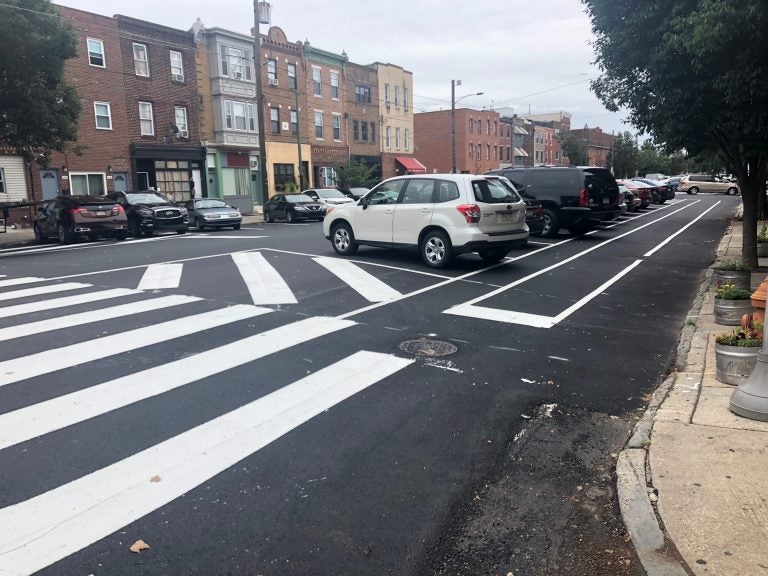Debate over how to best make streets safer divides South Philly, one of the nation’s most biked neighborhoods
South Philadelphia has one of the nation’s highest rates of bike commuters. That fact alone can’t solve the neighborhood’s street design divide.

Philadelphia recently repaved South 11th Street, creating new parking-protected bike lanes, as seen here. (Darryl Murphy/WHYY)
Only three communities in the U.S. boast a higher rate of bicycle commuting than the section of Southeast Philadelphia that South 11th Street runs through, according to U.S. Census data.
But that top national ranking is no comfort to area residents inflamed by the city’s decision to remove 18 to 24 parking spaces on South 11th between Reed and Bainbridge to make way for safer intersections.
“Whose idea was it? That’s what I want to know,” South Philadelphia resident Sarah Pinto said to a PlanPhilly reporter on a recent morning. A recent 6ABC Action News segment about the “battle” has gone viral with a clip of infuriated neighbors. “I want to ask them,” one neighbor yells, referring to city officials, “where do you park?”
The parking spaces will disappear to allow the city to create wide safety buffers at intersections. The street remake will also include parking-protected double bike lanes, which have a row of street parking between vehicle traffic and the bike lane. Removing parking from intersections, known as “daylighting” helps improve safety for drivers as well as pedestrians and cyclists.
Randy LoBasso, policy manager for the Bicycle Coalition of Greater Philadelphia, described the design as “the best possible” option for the busy two-way street.
Slightly more than 8% of commuters travel to work by bike in the census tract that encompasses the blocks in question. That figure ranks the South Philly neighborhood fourth in the nation for cycle commuting and puts the area on par with Santa Cruz, Ca.
Kelley Yemen, director of the city’s Complete Streets effort, said the Office of Transportation, Infrastructure and Safety did its due diligence to find the right balance between loss of parking and safety gains. The stretch of road has seen 31 crashes, with 28 resulting in injury, between 2013 and 2017. Ten involved bicyclists. Nine involved pedestrians.
“We know it’s going to be an adjustment period,” Yemen said. “This is going to be a huge safety improvement for all modes [of transportation] on the street.”
Yemen said the new design will improve safety with better sightlines for motorists, pedestrians, and bus drivers on the lookout for passengers. Plus, by repositioning the bike lane behind parked cars, the road will become narrower to help prevent double-parking or passing, for a “more consistent traffic flow” with “safer speeds.”
The full reconstruction of 11th Street should be done in the fall, Yemen said.
The project is part of the City’s more than $200 million investment dedicated to improving its streets and roads.
Before the project, the city surveyed more than 50 people about safety conditions on the street. More than half of the respondents said they prefer to walk on narrower 10th or 12th streets than 70-foot wide 11th street, which is the border between the Hawthorne and Bella Vista neighborhoods.
Respondents also voiced concerns about drivers speeding and running red lights.
LoBasso said the city did significant outreach to ensure that residents had a chance to weigh in about the changes and express concerns.
“The city went above and beyond to talk to neighbors and keep as much parking as possible,” LoBasso said.
He said the latest outcry is part of an annual cycle.
Summer is bikelash season — the time of the year when people complaining about parking make news, LoBasso said.
“It’s paving season and it’s a downtime for big news stories.”
Correction: An earlier version of this article incorrectly described the buffers included in the street redesign due to an editing error.
WHYY is your source for fact-based, in-depth journalism and information. As a nonprofit organization, we rely on financial support from readers like you. Please give today.







